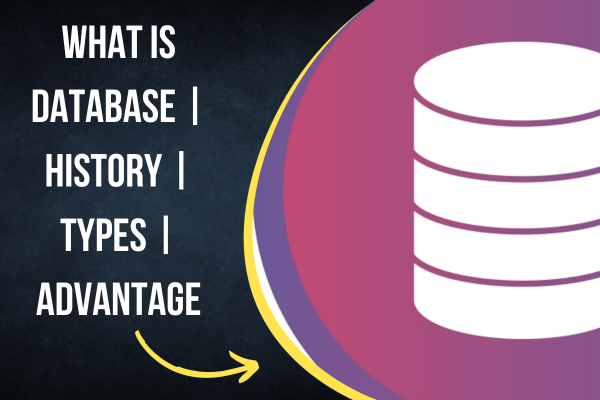A database is a collection of organized data that is stored and managed on a computer system. It is designed to allow for efficient data retrieval and management, making it an essential component of many modern software applications. Databases are used in a wide range of industries, from finance and healthcare to e-commerce and social media.
The primary purpose of a database is to store and manage large amounts of data in a structured and efficient way. This is achieved by breaking down the data into smaller pieces called tables, each of which contains information about a specific type of data. For example, a database for an online retailer might contain tables for products, customers, orders, and inventory.
Each table is made up of rows and columns, with each row representing a single record and each column representing a specific piece of data about that record. For example, a customer table might have columns for name, address, email, and phone number. The rows in the table would then represent individual customers, with each row containing the customer’s information.
Databases use a variety of techniques to manage and organize data, such as indexing, caching, and query optimization. Indexing is the process of creating a data structure that allows for faster retrieval of data, while caching involves temporarily storing frequently accessed data in memory to reduce the number of database requests. Query optimization involves analyzing queries to identify the most efficient way to retrieve the requested data.
There are several types of databases, each with its own strengths and weaknesses. The most common type of database is the relational database, which organizes data into tables and uses SQL (Structured Query Language) to query and manage the data. Other types of databases include NoSQL databases, which use non-relational data models, and object-oriented databases, which store data in objects rather than tables.
Relational databases are the most widely used type of database, and are used in a variety of applications, from small-scale personal projects to large-scale enterprise applications. They are designed to provide a high degree of flexibility, allowing developers to create custom data models and relationships between tables.
In addition to storing and managing data, databases also provide a range of other features and capabilities. For example, many databases include built-in security features to protect against unauthorized access and data breaches. They may also include tools for data backup and recovery, data migration, and data analysis.
One of the most significant benefits of using a database is that it provides a centralized location for data storage and management. This makes it easier for multiple applications and users to access and share data, and reduces the likelihood of data inconsistencies or errors.
Another key benefit of databases is their scalability. Databases can be easily scaled up or down to accommodate changes in data volume or user traffic, making them a flexible solution for applications of all sizes. Additionally, many databases offer cloud-based hosting options, which allow for easy deployment and management without the need for on-site infrastructure.
History of Database
The history of databases dates back to the 1960s, when the need for more efficient data storage and retrieval became increasingly important as computer systems grew in complexity. Here is a brief overview of the major milestones in the history of databases:
- The CODASYL Model (1960s): The Conference on Data Systems Languages (CODASYL) developed a model for data management that became the basis for many early database systems. This model focused on hierarchical data organization, where data was organized in a tree-like structure with parent-child relationships.
- Relational Model (1970s): In 1970, Edgar F. Codd published a paper on the relational model of data management, which proposed a new way of organizing data based on tables with rows and columns. This model became the basis for the modern relational database management system (RDBMS) and is still widely used today.
- IBM System R (1970s): IBM System R was the first RDBMS to implement Codd’s relational model. It was developed by IBM researchers in the 1970s and was the basis for many later commercial database systems.
- SQL (1970s): Structured Query Language (SQL) was developed by IBM researchers in the 1970s as a standard language for querying and manipulating relational databases. SQL has become the standard language for RDBMSs and is used by almost all modern databases.
- Oracle Database (1979): Oracle Corporation released its first commercial RDBMS in 1979. It was based on the relational model and used SQL as its query language. Today, Oracle Database is one of the most widely used commercial database systems.
- Object-Oriented Databases (1980s): In the 1980s, object-oriented programming became popular and led to the development of object-oriented databases (OODBs). These databases store data as objects rather than rows and columns, allowing for more complex data structures.
- NoSQL (2000s): In the early 2000s, the need for more flexible and scalable databases led to the development of NoSQL databases. These databases use non-relational data models and are designed to handle large volumes of unstructured data.
- Cloud-Based Databases (2010s): In recent years, cloud-based databases have become increasingly popular. These databases are hosted in the cloud and are accessible from anywhere with an internet connection. They offer easy scalability and reduced maintenance costs compared to on-premise databases.
Applications of Database
Databases are used in a wide variety of applications across many different industries. Here are some of the most common applications of databases:
- Business: Databases are essential for managing business operations, from inventory and customer information to sales and financial data. Companies use databases to store and retrieve information related to their products, customers, suppliers, employees, and other aspects of their operations. Business intelligence tools are often used to analyze this data to make better decisions.
- Healthcare: In healthcare, databases are used to store and manage patient records, including medical histories, test results, and treatment plans. Electronic Health Records (EHRs) have become increasingly popular in recent years, allowing healthcare providers to share patient information more easily and improve patient care.
- Education: Educational institutions use databases to manage student information, including enrollment data, grades, and academic progress. Databases also allow schools to track student attendance, manage course schedules, and store educational resources.
- Finance: Banks and financial institutions use databases to manage customer accounts, track transactions, and monitor financial data. These databases are essential for detecting fraud and ensuring compliance with regulations.
- Government: Government agencies use databases to store and manage a wide range of information, from tax records and social security data to crime statistics and census information. Databases also play a critical role in emergency response systems, allowing first responders to access critical information quickly in the event of a crisis.
- E-commerce: E-commerce websites rely on databases to manage product catalogs, customer orders, and payment processing. These databases are critical for ensuring that orders are processed accurately and inventory levels are updated in real-time.
- Social media: Social media platforms use databases to store user profiles, messages, and other types of content. These databases are essential for providing users with personalized experiences and ensuring that content is delivered in real-time.
- Logistics and transportation: Logistics and transportation companies use databases to manage supply chain operations, including inventory tracking, shipping schedules, and delivery routes. Databases also play a critical role in managing fleet operations, including vehicle maintenance and fuel management.
Types of Database
There are several types of databases, each designed to handle different types of data and applications. Here are some of the most common types of databases:
- Relational databases: Relational databases are the most widely used type of database. They organize data into tables, where each table represents a type of data (such as customers, orders, or products) and each row in the table represents a specific instance of that data. Relational databases use SQL (Structured Query Language) to manage and manipulate data.
- NoSQL databases: NoSQL databases are designed to handle large volumes of unstructured or semi-structured data, such as social media posts or sensor data. They are often used in applications that require high scalability and availability, such as big data and real-time analytics. Unlike relational databases, NoSQL databases do not use tables or SQL and may have flexible schemas that allow for easier data manipulation.
- Object-oriented databases: Object-oriented databases are designed to store complex data structures, such as objects, classes, and inheritance relationships. They are often used in applications that require sophisticated data modeling, such as scientific research and computer-aided design.
- Graph databases: Graph databases are designed to handle data that has complex relationships, such as social networks or recommendation systems. They use graph structures (nodes and edges) to represent data and allow for more efficient querying of relationship-based data.
- Document databases: Document databases are designed to store and manage semi-structured or unstructured data in the form of documents, such as PDFs or XML files. They are often used in content management systems, where documents need to be stored and accessed in a flexible and efficient way.
- Time-series databases: Time-series databases are designed to handle time-series data, such as sensor data or stock prices. They are optimized for time-based querying and can handle large volumes of data in real-time.
- Spatial databases: Spatial databases are designed to handle spatial data, such as maps or geographic information. They are often used in applications that require location-based querying, such as logistics or urban planning.
Advantage of Database
Databases offer several advantages over traditional file-based data management systems. Here are some of the key advantages of using a database:
- Data integrity: Databases are designed to ensure data integrity, which means that the data stored in the database is accurate, consistent, and complete. This is achieved through the use of data validation rules, referential integrity constraints, and transaction processing.
- Data consistency: Databases ensure data consistency by allowing multiple users to access and update the same data simultaneously, without risking conflicts or data inconsistencies. This is achieved through the use of locking mechanisms and concurrency control.
- Improved data sharing: Databases allow multiple users to access and share data, making it easier to collaborate and share information across different departments or teams. This can improve productivity, reduce duplication of effort, and facilitate knowledge sharing.
- Reduced data redundancy: Databases reduce data redundancy by storing data in a centralized location, where it can be accessed and updated by multiple applications. This reduces the risk of data inconsistencies and improves data accuracy.
- Improved data security: Databases offer improved data security through the use of access controls, encryption, and other security measures. This helps to protect sensitive information from unauthorized access, theft, or corruption.
- Improved data backup and recovery: Databases offer improved data backup and recovery capabilities, making it easier to recover from data loss or system failures. This is achieved through the use of backup and recovery tools, as well as transaction logging and other recovery mechanisms.
- Improved performance: Databases can improve performance by optimizing data storage and retrieval, reducing data access times, and improving query performance. This can help to improve application performance, reduce processing times, and increase user satisfaction.
Disadvantage of Database
While databases offer many advantages, there are also some disadvantages to consider. Here are some of the key disadvantages of using a database:
- Complexity: Databases can be complex and require specialized knowledge and training to design, implement, and maintain. This can make them more difficult to manage and maintain than simple file-based data management systems.
- Cost: Databases can be expensive to implement and maintain, especially for large organizations or complex applications. This is due to the need for specialized hardware and software, as well as the cost of licensing and ongoing maintenance.
- Scalability: While databases are designed to scale and handle large amounts of data, they can be difficult to scale in practice. This is especially true for relational databases, which may require significant redesign to handle large volumes of data.
- Security risks: While databases offer improved data security, they also present new security risks, such as SQL injection attacks, data breaches, and other vulnerabilities. These risks must be carefully managed through the use of security best practices, such as access controls, encryption, and regular security audits.
- Performance overhead: Databases can introduce performance overhead due to the need for data indexing, caching, and other optimization techniques. This can impact application performance and increase processing times, especially for large or complex queries.
- Vendor lock-in: Databases often require specialized software and hardware, which can lead to vendor lock-in and make it difficult to switch to a different database vendor or platform.
Conclusion of Databases
In conclusion, databases are an essential component of modern software applications, providing a centralized and efficient way to store and manage large amounts of data. With their wide range of features and capabilities, databases are a flexible and scalable solution that can be tailored to meet the needs of virtually any application or industry. As technology continues to advance, it is likely that databases will continue to play a critical role in the development and success of new software applications.





Leave a Reply